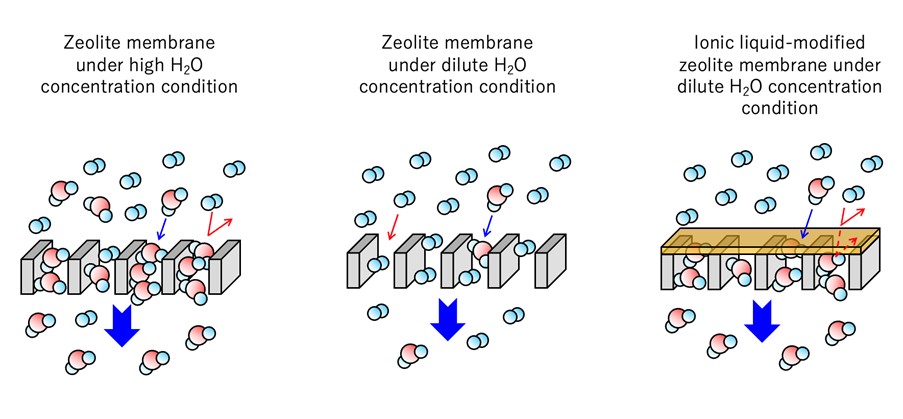RESEARCH NEWS - Towards New Ionic Liquid-Modified Zeolite Membranes for Efficient CO2 Conversion
Category:News|Publishing : October 21, 2025
An effective strategy to address increasing greenhouse gas emissions and combat climate change is the capture and reuse of carbon dioxide (CO2). The reaction of CO2 and hydrogen (H2) can produce industrially useful chemicals, such as methanol and carbon monoxide, and synthetic fuels. However, in traditional reactors these chemical processes are limited by thermodynamic constraints and slow reaction rates, resulting in a low CO2 conversion. This is because these reactors reach equilibrium before all the reactants are converted into desired products. To increase reaction speed, higher temperatures or pressures are required, but this increases energy consumption, posing a major challenge for CO2 utilization technologies.
Membrane reactors are a promising solution to this problem. These reactors use hydrophilic membranes to selectively remove water (H2O), a common byproduct in CO2 conversion reactions while retaining the reactants. This shifts the reaction equilibrium towards the products, improving CO2 conversion and yields. Zeolitic membranes, such as those based on ZSM-5, are attractive candidates for membrane reactors. These materials can selectively adsorb water molecules within their micropores, preventing permeation of reactants like H2. However, at high temperatures and low H2O concentrations, which are typical in real-world operating conditions, their performance gets degraded due to poor pore blocking, allowing H2 to permeate along with H2O molecules. This in turn limits the practical applicability of membrane reactors.
To address this issue, a research team led by Associate Professor HIROTA Yuichiro Hirota from the Department of Life Science and Applied Chemistry at Nagoya Institute of Technology in Japan recently developed new ZSM-5 membranes modified by a silsesquioxane framework containing ionic liquids (SQILs). "In previous studies, ionic liquid coating has been shown to improve the H2O capture capacity of metal-organic framework membranes," says Dr. HIROTA. "Building on this result, we designed SQIL-modified ZSM-5 membranes that maintain high H2O permselectivity even under dilute H2O concentrations and high temperatures. We also analyzed how hydrophilicity of the SQIL and ZSM layers contributes to this performance."
The study, which included contributions from Assistant Professor SAKAI Motomu from Waseda University, Japan, was made available online on August 18, 2025, and will be published in Volume 735 of the Journal of Membrane Science on November 01, 2025.
In their study, the team fabricated two SQILs from polymerized 1-methyl-3-(1-triethoxysilylpropyl)imidazolium (Sipmim) cations: one containing trifluoromethanesulfonate (OTf-) anions, forming polySipmimOTf, and the other containing bis(trifluoromethylsulfonyl)imide (Tf2N-) anions, forming polySipmimTf2N. In the tests conducted, polySipmimOTf was found to be more hydrophilic of the two.
Furthermore, the team prepared two ZSM-5 membranes: a hydrophilic sodium cation (Na+)-type (NaZ-5) and a less hydrophilic hydrogen cation (H+)-type (HZ-5). The surfaces of these membranes were then modified with SQILs and tested for H2 gas permeation and H2O permselectivity at different concentrations at a temperature of 473 K (200 ℃).
The results showed that SQIL modification significantly reduced H2 permeability and enhanced H2O permselectivity compared to that of unmodified ZSM-5 membranes. Moreover, membranes modified with polySipmimOTf performed better compared to those modified with polySipmimTf2N. Furthermore, polySipmimOTf-modified NaZ-5 (OTf-/NaZ-5) showed significantly better H2O permselectivity, outperforming the Otf-/HZ-5 membranes.
Importantly, the SQIL-modified ZSM-5 membranes retained low H2 permeation even at dilute H2O concentrations while maintaining high H2O permeation at elevated concentrations. The team attributed this finding to a synergistic effect arising from combining hydrophilic SQIL and ZSM layers. As Dr. HIROTA explains, "The superior dehydration of the SQIL-modified membranes arises from three factors: the low H2 solubility and high hydrophilicity of SQILs, which minimize H2 permeation at low H2O concentrations; the selective adsorption and capillary condensation of H2O in ZSM-5 micropores; and the shift in H2O sorption from Langmuir-type to Henry-type owing to SQIL modification."
"The effective conversion of CO2 into chemicals and fuels is essential for achieving carbon neutrality and a circular economy," adds Dr. HIROTA. "Our SQIL-modified membranes can help improve CO2 conversion efficiency in membrane reactors and could pave the way for their broader adoption."
Indeed, these innovative membranes could open doors to more efficient and practical membrane reactors for CO2 conversion, potentially contributing to reduced carbon emissions and energy conservation in chemical industries and mitigating the effects of global warming.

Researchers modify silsesquioxane framework containing ionic liquid-modified zeolite membranes with broader implications to reduce CO2 emission
Reference
|
Title of original paper |
Silsesquioxane framework containing ionic liquid−modified NaZSM-5 |
|
Journal |
Journal of Membrane Science |
|
DOI |
10.1016/j.memsci.2025.124568 |
|
Latest Article Publication Date |
1 November 2025 |
About Associate Professor HIROTA Yuichiro from Nagoya Institute of Technology, Japan
Dr. HIROTA Yuichiro obtained his Master's and PhD degrees in Engineering from Osaka University in 2009 and 2012, respectively and joined Nagoya Institute of Technology as an Associate Professor in 2020. His research focuses on nanostructured materials, such as nanoporous inorganic and organic/inorganic hybrid materials and nano-scale reactors. In addition, Dr. HIROTA investigates membrane separation and catalytic reaction processes using such compounds. He has published over 70 research papers on these topics.
Funding information
This study was supported by the Kazuchika Okura Memorial Foundation and Tokai Foundation for Technology.
Contact
Associate Professor HIROTA Yuichiro
Website : https://pure.nitech.ac.jp/en/persons/yuichiro-hirota
E-mail : hirota.yuichiro [at] nitech.ac.jp
*Please replace [at] with @ when contacting.
[Initiative Introduction] - Towards realizing regional collaboration using public spaces - Tsurumai Chikusa Mizumatsuri - [Initiative Introduction] - Supporting physical movement through sensory stimulation

 Japanese
Japanese